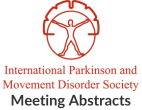Abstract: Trends in Movement Disorders related death in the United States from 1999 to 2020
Objective: We aimed to analyze the mortality and prevalence of movement disorders in the United States from 1999 to 2020 to compare disparities among various…Levels of ferritinemia in Parkinson’s disease patients who underwent Covid-19
Objective: Comparison of serum IL-6 levels in Parkinson's disease (PD) patients with and without Сovid-19. Background: In the scientific literature, there is information about the…MOVE-PD: Mapping the Correlation of Sedentary behavior with Motor Symptoms in Parkinson’s Disease
Objective: Mapping the correlation between sedentary behavior (SB) and Parkinsons (PD) specific motor symptoms, measured on objective data from wearables. Background: People with Parkinson's (Pwp)…The Spatiotemporal Characteristics of Floor Sitting Rising in Parkinson’s Disease (PD)
Objective: To develop a method to characterize Floor Sitting Rising (FSR) in people with Parkinson disease (PwP). Background: Transitioning to the floor to a seated…Coordinated Reset Vibrotactile Therapy for the Treatment of Bradykinesia in Parkinson’s Disease Patients
Objective: The present research examines a novel non-invasive vibrotactile device for stimulation of fingertips in a pattern that aims to disrupt pathological physiological beta-band oscillations…Characterising early morning akinesia and off (EMO) using Parkinson’s kinetigraph: analysis from a two centre national database in Parkinson’s disease .
Objective: Could wearable sensors such as Parkinson’s kinetograph (PKG) may provide valuable overnight data to detect EMO to augment care in clinic. Background: Early morning…A Machine Learning Approach for Early Identification of Prodromal Parkinson’s Disease
Objective: The aim of this project is to analyze available data of voice, Tappy keystroke, spiral drawings, and gait sample data involving PD patients and…A Kinematic and fMRI Study of the Neural Correlates of Bradykinesia in Parkinson’s Disease
Objective: This study aimed at investigating the neural and kinematic correlates of bradykinesia during hand-tapping in people with Parkinson’s disease (pwPD) relative to healthy controls.…Study of Wearable Technology And Geo-Fencing Device for Quantification of Freezing of Gait And Sleep Pattern In Dystonia Patients In Gurugram City, India
Objective: The aim of study was to investigate the benefits of wearable devices (Amazfit GTS-3 watch ) and geo-fencing technology to monitor daily life routine…Continuous Monitoring of Hypomimia in Parkinson’s disease using a Sensor-equipped Cap
Objective: We propose an e-textile in form of a cap to continuously track hypomimia in Parkinson’s disease (PD) allowing for an unobtrusive monitoring of facial…
- 1
- 2
- 3
- …
- 22
- Next Page »
